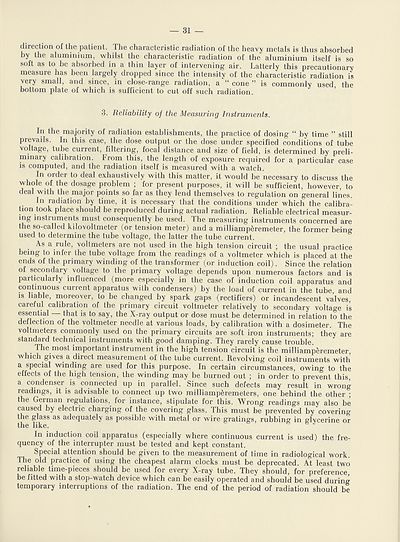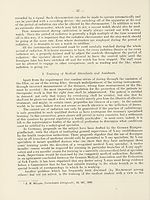Health > Protective measures against dangers resulting from the use of radium, roentgen and ultra-violet rays
(33)
Download files
Complete book:
Individual page:
Thumbnail gallery: Grid view | List view

— 31 —
direction of the patient. I he characteristic radiation of the heavy metals is thus absorbed
by the aluminium, whilst the characteristic radiation of the aluminium itself is so
soft as to be absorbed in a thin layer of intervening air. Latterly this precautionary
measure has been largely dropped since the intensity of the characteristic radiation is
very small, and since, in close-range radiation, a 44 cone ” is commonly used the
bottom plate of which is sufficient to cut off such radiation.
3. Reliability of the Measuring Instruments.
In the majority of radiation establishments, the practice of dosing “ by time ” still
prevails. In this case, the dose output or the dose under specified conditions of tube
voltage, tube current, filtering, focal distance and size of field, is determined by preli¬
minary calibration. From this, the length of exposure required for a particular case
is computed, and the radiation itself is measured with a watch.
In order to deal exhaustively with this matter, it would be necessary to discuss the
whole of the dosage problem ; for present purposes, it will he sufficient, however, to
deal with the major points so far as they lend themselves to regulation on general lines.
In radiation by time, it is necessary that the conditions under which the calibra¬
tion took place should be reproduced during actual radiation. Reliable electrical measur¬
ing instruments must consequently be used. The measuring instruments concerned are
the so-called kilovoltmeter (or tension meter) and a milliamperemeter, the former being
used to determine the tube voltage, the latter the tube current.
As a rule, voltmeters are not used in the high tension circuit j the usual practice
being to infer the tube voltage from the readings of a voltmeter which is placed at the
ends of the primary winding of the transformer (or induction coil). Since the relation
of secondary voltage to the primary voltage depends upon numerous factors and is
particularly influenced (more especially in the case of induction coil apparatus and
continuous current apparatus with condensers) by the load of current in the tube, and
is liable, moreover, to be changed by spark gaps (rectifiers) or incandescent valves,
careful calibration of the primary circuit voltmeter relatively to secondary voltage is
essential that is to say, the X-ray output or dose must be determined in relation to the
deflection of the voltmeter needle at various loads, by calibration with a dosimeter. The
voltmeters commonly used on the primary circuits are soft iron instruments; they are
standard technical instruments with good damping. They rarely cause trouble.
The most important instrument in the high tension circuit is the milliamperemeter,
which gives a direct measurement of the tube current. Revolving coil instruments with
a special winding are used for this purpose. In certain circumstances, owing to the
effects of the high tension, the winding may be burned out ; in order to prevent this,
a condensei is connected up in parallel. Since such defects may result in wrong
readings, it is advisable to connect up two milliamperemeters, one behind the other ;
the Geiman legulations, for instance, stipulate for this. Wrong readings may also be
caused by electric charging of the covering glass. This must be prevented by covering
the glass as adequately as possible with metal or wire gratings, rubbing in glycerine or
the like.
In induction coil apparatus (especially where continuous current is used) the fre¬
quency of the interrupter must be tested and kept constant.
Special attention should be given to the measurement of time in radiological work.
The old practice of using the cheapest alarm clocks must be deprecated. At least two
reliable time-pieces should be used for every X-ray tube. They should, for preference,
be fitted with a stop-watch device which can be easily operated and should be used during
temporary interruptions of the radiation. The end of the period of radiation should be
direction of the patient. I he characteristic radiation of the heavy metals is thus absorbed
by the aluminium, whilst the characteristic radiation of the aluminium itself is so
soft as to be absorbed in a thin layer of intervening air. Latterly this precautionary
measure has been largely dropped since the intensity of the characteristic radiation is
very small, and since, in close-range radiation, a 44 cone ” is commonly used the
bottom plate of which is sufficient to cut off such radiation.
3. Reliability of the Measuring Instruments.
In the majority of radiation establishments, the practice of dosing “ by time ” still
prevails. In this case, the dose output or the dose under specified conditions of tube
voltage, tube current, filtering, focal distance and size of field, is determined by preli¬
minary calibration. From this, the length of exposure required for a particular case
is computed, and the radiation itself is measured with a watch.
In order to deal exhaustively with this matter, it would be necessary to discuss the
whole of the dosage problem ; for present purposes, it will he sufficient, however, to
deal with the major points so far as they lend themselves to regulation on general lines.
In radiation by time, it is necessary that the conditions under which the calibra¬
tion took place should be reproduced during actual radiation. Reliable electrical measur¬
ing instruments must consequently be used. The measuring instruments concerned are
the so-called kilovoltmeter (or tension meter) and a milliamperemeter, the former being
used to determine the tube voltage, the latter the tube current.
As a rule, voltmeters are not used in the high tension circuit j the usual practice
being to infer the tube voltage from the readings of a voltmeter which is placed at the
ends of the primary winding of the transformer (or induction coil). Since the relation
of secondary voltage to the primary voltage depends upon numerous factors and is
particularly influenced (more especially in the case of induction coil apparatus and
continuous current apparatus with condensers) by the load of current in the tube, and
is liable, moreover, to be changed by spark gaps (rectifiers) or incandescent valves,
careful calibration of the primary circuit voltmeter relatively to secondary voltage is
essential that is to say, the X-ray output or dose must be determined in relation to the
deflection of the voltmeter needle at various loads, by calibration with a dosimeter. The
voltmeters commonly used on the primary circuits are soft iron instruments; they are
standard technical instruments with good damping. They rarely cause trouble.
The most important instrument in the high tension circuit is the milliamperemeter,
which gives a direct measurement of the tube current. Revolving coil instruments with
a special winding are used for this purpose. In certain circumstances, owing to the
effects of the high tension, the winding may be burned out ; in order to prevent this,
a condensei is connected up in parallel. Since such defects may result in wrong
readings, it is advisable to connect up two milliamperemeters, one behind the other ;
the Geiman legulations, for instance, stipulate for this. Wrong readings may also be
caused by electric charging of the covering glass. This must be prevented by covering
the glass as adequately as possible with metal or wire gratings, rubbing in glycerine or
the like.
In induction coil apparatus (especially where continuous current is used) the fre¬
quency of the interrupter must be tested and kept constant.
Special attention should be given to the measurement of time in radiological work.
The old practice of using the cheapest alarm clocks must be deprecated. At least two
reliable time-pieces should be used for every X-ray tube. They should, for preference,
be fitted with a stop-watch device which can be easily operated and should be used during
temporary interruptions of the radiation. The end of the period of radiation should be
Set display mode to:
![]() Universal Viewer |
Universal Viewer | ![]() Mirador |
Large image | Transcription
Mirador |
Large image | Transcription
Images and transcriptions on this page, including medium image downloads, may be used under the Creative Commons Attribution 4.0 International Licence unless otherwise stated. ![]()
| League of Nations > Health > Protective measures against dangers resulting from the use of radium, roentgen and ultra-violet rays > (33) |
|---|
| Permanent URL | https://digital.nls.uk/191800615 |
|---|
| Shelfmark | LN.III |
|---|---|
| Description | Over 1,200 documents from the non-political organs of the League of Nations that dealt with health, disarmament, economic and financial matters for the duration of the League (1919-1945). Also online are statistical bulletins, essential facts, and an overview of the League by the first Secretary General, Sir Eric Drummond. These items are part of the Official Publications collection at the National Library of Scotland. |
|---|---|
| Additional NLS resources: |
|

